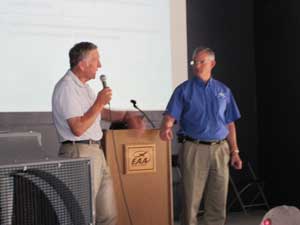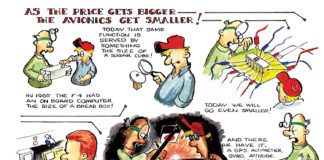All week at AirVenture, we waited to hear something from the Feds about the rules that govern our industry. In late spring, we were told the new rules package-sorry, advisory material, as the FAA has not in fact changed any laws-would appear at Oshkosh.
I continued to ask around and then discovered, almost by accident, a forum to be held by the EAAs Earl Lawrence on Friday to discuss the issue. Something you should know about that: Oshkosh has continued to evolve as a news-gathering event. It used to be you could have a press conference any time during the show. Thanks to the Internet, no more. The vast majority of the news announcements happen in the first 48 hours, with many press conferences kicking off before the show technically starts. I figured the late announcement was a hedge in case the rule wasn’t quite ready.

Dick VanGrunsven (left) and the EAAs Earl Lawrence address the Friday crowd at AirVenture.
While no FAA personnel were on hand for the Friday seminar-and, yes, the rule wasn’t quite ready-Lawrence said he was given the green light by the agency to talk about the substance of the new rules, which were expected to be published in the Federal Register on August 17. (This is being written after that deadline, and the rules have not made the Federal Register. We expect that the document will have been published in time for a thorough review in our next issue.)
After receiving a torrent of commentary last year at Oshkosh, the FAA went back to the drawing board and agreed to reconvene the rulemaking committee made up of industry and the FAA. The new rules, which will be in final form (there will be no more comment periods), are expected to clarify a lot of issues that were muddied by the first round of proposed changes and, industry insiders agree, successfully curtail the excessive use of commercial assistance while not endangering legitimate builders.
Chief among the expected revisions is the elimination of the 20/20/11 idea. In last years efforts, the FAA said it wanted to see 20% of the assembly work on any Experimental/Amateur-Built kit to be performed by the builder, as well as at least 20% of fabrication; the remaining 11% could be either, totaling 51% for the builder. Moreover, the FAA had made the definition of fabrication much less clear and far more restrictive than it had been previously interpreted. The new rules look to be much more rational and acknowledge that much fabrication in modern kits is along the lines of finishing or final-prepping a part; they are expected to give credit toward fabrication for this kind of process.
These rules will be wrapped into a single new Advisory Circular, which will contain substantial guidance for builders. In addition, the previous checklist that received so much criticism-it gave equal weight to finishing a trimtab as to building an entire engine-has been substantially revised and will be parsed so that each operation can have a 0.1 percentage qualification. Before, either the builder got all of the credit for the operation, or none; the remaining credit could go to either the kit manufacturer or to commercial assistance. Under the new rules, its expected that builders will still have to list which processes were performed by the kit maker, the builder (both as assembly and fabrication) or by commercial assistance.
Kits started before the implementation of the new rules are expected to be grandfathered so that they must only comply with the rules in place when the project began, though Dick VanGrunsven, who was on the advisory panel, indicated that the new rules are clear enough and just liberal enough that most builders wont see much advantage in using the older rules.
The FAA is expected to revise the language in the forms the builder signs confirming he built the majority of the airplane-for the purpose of increased enforcement of the rules going forward. Plus, anyone who assists in the construction of the airplane must be named, so there’s no way to hide commercial assistance. Overall, I like what Ive heard so far. The rules seem reasonable and workable for legitimate builders. That was the best news of the show by far.

![]()
Marc Cook has been in aviation journalism for 20 years and in magazine work for more than 25. He is a 4000-hour instrument-rated, multi-engine pilot with experience in nearly 150 types. Hes completed two kit aircraft, an Aero Designs Pulsar XP and a Glastar Sportsman 2+2.




